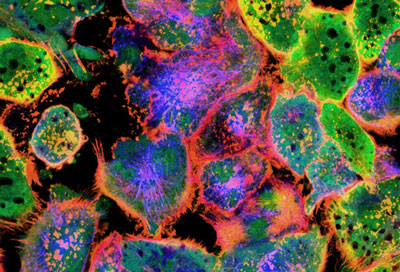Cancer can be caused by protein imbalances within cells
Posted: 27 July 2015 | Victoria White
Genetic aberrations have been seen as the main cause of almost all cancer but new research shows cancer can be caused solely by protein imbalances…


Cancer can be caused solely by protein imbalances within cells, a study of ovarian cancer has found.
The discovery is a major breakthrough because, until now, genetic aberrations have been seen as the main cause of almost all cancer.
The research, led by scientists at the University of Leeds and the MD Anderson Cancer Centre, demonstrates that protein imbalance is a powerful prognostic tool, indicating whether or not patients are likely to respond to chemotherapy and whether a tumour is likely to spread to other sites. The findings also open the possibility of new therapies aimed at measuring and preventing dangerous imbalances in cells.
Professor John Ladbury, Dean of the University of Leeds’ Faculty of Biological Sciences and Professor of Mechanistic Biology, said, “There has been huge investment in sequencing the human genome with the idea that if we get all the relevant genetic information we can predict whether you have a predisposition to cancer and, ultimately, use a precision medicine-based approach to develop a therapeutic approach. Our study demonstrates that genetic screening alone is not enough.”
The research focused on the “Akt pathway,” a signalling pathway within cells that drives cancer formation and the spread of cancers through the body.
Under normal conditions, the cell receives external signals through a cell wall-bound receptor (FGFR2 in this study). As a result of this stimulus the receptor is ‘switched on’ inside the cell. This results in the recruitment of signalling proteins and the initiation of the Akt pathway, which is responsible for committing the cell to proliferate. In some cancerous cells, this pathway is permanently switched on. A conventional approach to diagnosing this cancer would be to look for genetic modification of the receptor (or recruited proteins), which could be responsible for maintaining the switched on state.
Imbalance in the amount of Plcγ1 protein can lead to cell proliferation and cancer formation
The new study looked at isolated cancer cells without external stimulation and found that the “Akt pathway” could be activated without genetic modifications. Two proteins; Plcγ1 and Grb2, compete for binding to FGFR2. The relative concentration of these proteins will dictate which one binds. When Plcγ1 prevails, it triggers the Akt pathway. In this way, an imbalance in the amount of the two proteins can lead to cell proliferation and cancer formation.
Dr Zahra Timsah, University Academic Fellow at the University of Leeds’ School of Molecular and Cellular Biology, who was the lead researcher on the study, said, “This competition for binding to the receptor represents an unexpected way in which cancer can occur. We found that in cells where Grb2 is depleted, FGFR2 was vulnerable to Plcγ1 binding and that this triggered uncontrolled proliferation. Increasing the amount of Grb2 rescued this effect to maintain normal FGFR2 activity. What we think is happening is that under normal conditions the two proteins compete fairly evenly and that the Plcγ1 binding events allow useful cell housekeeping. When the proteins get imbalanced, Plcγ1 can get out of control.”
The researchers also looked at the process in a mouse model and found that Grb2 depletion results in the development of multiple tumours in the vicinity of a primary tumour, indicating that protein imbalance can have a role in metastasis, the spread of a cancer through the body. This makes sense because Plcγ1 can play a role in increasing cell movement.
A high level of Grb2 protein was associated with a more favourable prognosis in ovarian cancer patients
Finally, the researchers looked at whether imbalance between Grb2 and Plcγ1 was predictive of the progress of ovarian cancers in patients. Measuring the levels of the proteins in patient tissues followed by database analysis of clinical information from The Cancer Genome Atlas and other sources revealed that a high level of Grb2 relative to Plcγ1 and FGFR2 was associated with a significantly more favourable prognosis than patients with elevated levels of Plcγ1.
Statistical data reveal that just under 40% of patients with a favourable balance were still alive seven years after samples were taken. Less than 10% of patients with high levels of Plcγ1 and FGFR2 binding sites survived the same length of time.
Professor Ladbury said: “From the patient’s point of view, the key findings are that these proteins are biomarkers. They could offer information to clinicians on who is going to benefit from therapy and, just as importantly, who is not. On the treatment side, the proteins’ interaction could be a valid therapeutic target: you could, for instance, target Plcγ1 to ensure it does not overwhelm the cell.”
The research findings are published in the journal Oncogene.
Related organisations
Cancer Research, Leeds University, MD Anderson Cancer Centre



